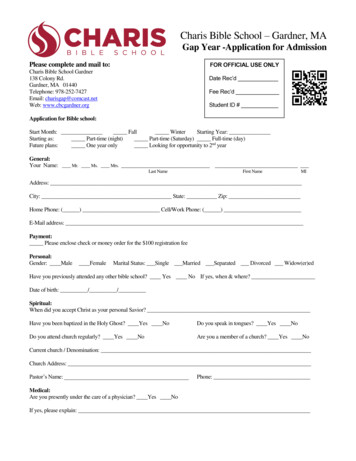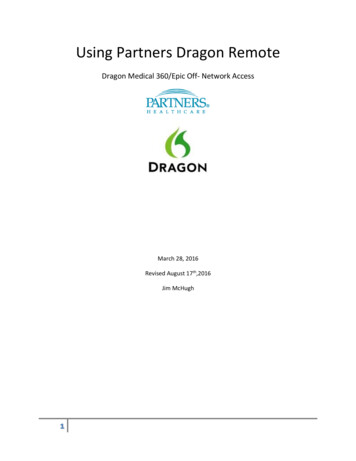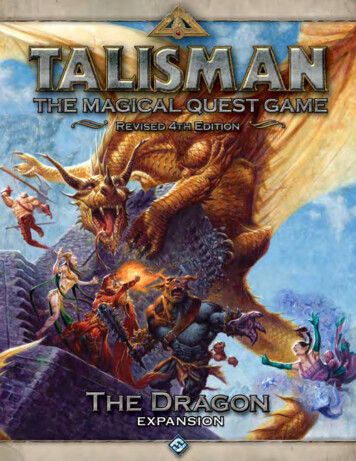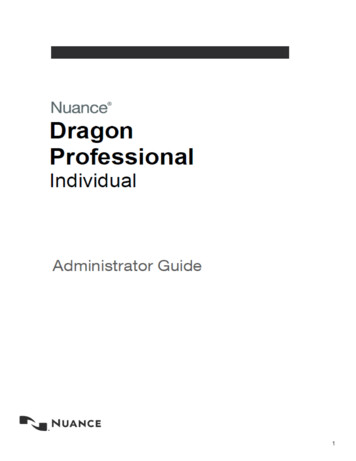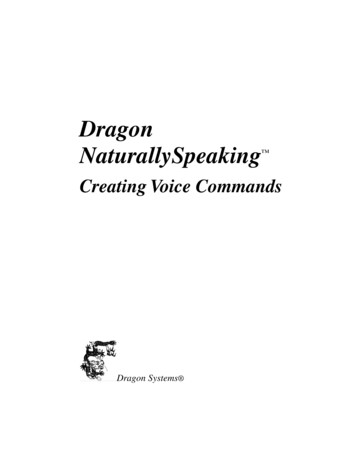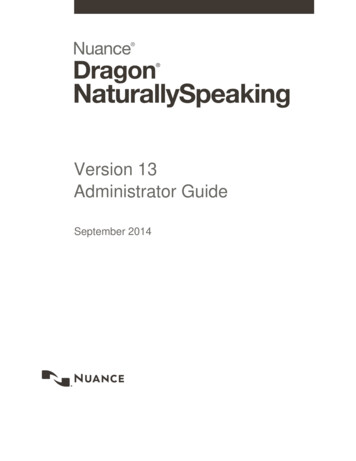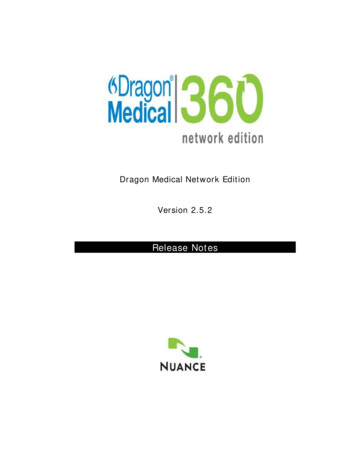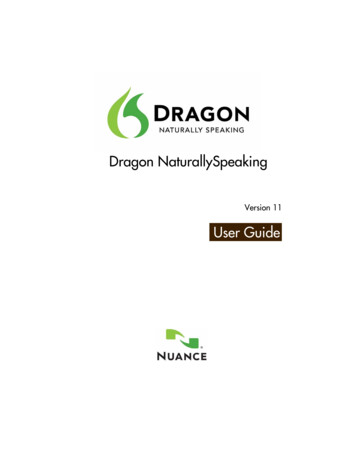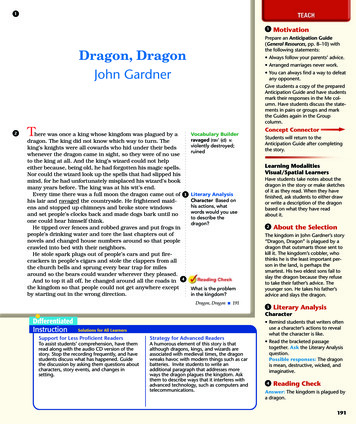
Transcription
11Prepare an Anticipation Guide(General Resources, pp. 8–10) withthe following statements:Dragon, DragonJohn Gardner2There was once a king whose kingdom was plagued by adragon. The king did not know which way to turn. Theking’s knights were all cowards who hid under their bedswhenever the dragon came in sight, so they were of no useto the king at all. And the king’s wizard could not helpeither because, being old, he had forgotten his magic spells.Nor could the wizard look up the spells that had slipped hismind, for he had unfortunately misplaced his wizard’s bookmany years before. The king was at his wit’s end.Every time there was a full moon the dragon came out of 3his lair and ravaged the countryside. He frightened maidens and stopped up chimneys and broke store windowsand set people’s clocks back and made dogs bark until noone could hear himself think.He tipped over fences and robbed graves and put frogs inpeople’s drinking water and tore the last chapters out ofnovels and changed house numbers around so that peoplecrawled into bed with their neighbors.He stole spark plugs out of people’s cars and put firecrackers in people’s cigars and stole the clappers from allthe church bells and sprung every bear trap for milesaround so the bears could wander wherever they pleased.And to top it all off, he changed around all the roads in 4the kingdom so that people could not get anywhere exceptby starting out in the wrong direction.Motivation Always follow your parents’ advice. Arranged marriages never work. You can always find a way to defeatany opponent.Give students a copy of the preparedAnticipation Guide and have studentsmark their responses in the Me column. Have students discuss the statements in pairs or groups and markthe Guides again in the Groupcolumn.Vocabulary Builderravaged (rav» ijd) v.violently destroyed;ruinedConcept ConnectorStudents will return to theAnticipation Guide after completingthe story.Learning ModalitiesVisual/Spatial LearnersLiterary AnalysisCharacter Based onhis actions, whatwords would you useto describe thedragon?What is the problemin the kingdom?Dragon, Dragon 191Have students take notes about thedragon in the story or make sketchesof it as they read. When they havefinished, ask students to either drawor write a description of the dragonbased on what they have readabout it.2About the SelectionThe kingdom in John Gardner’s story“Dragon, Dragon” is plagued by adragon that outsmarts those sent tokill it. The kingdom’s cobbler, whothinks he is the least important person in the land, is perhaps thesmartest. His two eldest sons fail toslay the dragon because they refuseto take their father’s advice. Theyounger son. He takes his father’sadvice and slays the dragon.3Literary AnalysisCharacterSupport for Less Proficient ReadersTo assist students’ comprehension, have themread along with the audio CD version of thestory. Stop the recording frequently, and havestudents discuss what has happened. Guidethe discussion by asking them questions aboutcharacters, story events, and changes insetting.Strategy for Advanced ReadersA humorous element of this story is thatalthough dragons, kings, and wizards areassociated with medieval times, the dragonwreaks havoc with modern things such as carbatteries. Invite students to write anadditional paragraph that addresses moreways the dragon plagues the kingdom. Askthem to describe ways that it interferes withadvanced technology, such as computers andtelecommunications. Remind students that writers oftenuse a character’s actions to revealwhat the character is like. Read the bracketed passagetogether. Ask the Literary Analysisquestion.Possible responses: The dragonis mean, destructive, wicked, andimaginative.4Reading CheckAnswer: The kingdom is plagued bya dragon.191
5Reading SkillMake Inferences Remind students that authors provide readers with details they canuse to make assumptions aboutcharacters and events. Rather thantell the reader that a certain character is this way or that way, thewriter might describe how a character thinks or feels. The readermust then make inferences aboutthe character’s feelings to betterunderstand the character. Ask the Reading Skill question.Then ask a volunteer to read aloudthe bracketed text. Tell students tolisten for details that the authorsupplies so that readers can makean inference about the cobbler.Possible response: He does notthink he is as important as they are.He lacks confidence.6Critical Viewing“That,” said the king in a fury, “is enough!” And he calleda meeting of everyone in the kingdom.Now it happened that there lived in the kingdom a wise 5old cobbler who had a wife and three sons. The cobbler andhis family came to the king’s meeting and stood way inback by the door, for the cobbler had a feeling that since hewas nobody important there had probably been some mistake, and no doubt the king had intended the meeting foreveryone in the kingdom except his family and him.“Ladies and gentlemen,” said the king when everyone waspresent, “I’ve put up with that dragon as long as I can. Hehas got to be stopped.”All the people whispered amongst themselves, and theking smiled, pleased with the impression he had made.But the wise cobbler said gloomily, “It’s all very well totalk about it—but how are you going to do it?”6And now all the people smiled and winked as if to say,“Well, King, he’s got you there!”The king frowned.“It’s not that His Majesty hasn’t tried,” the queen spokeup loyally.Reading SkillMake InferencesHow does thecobbler think he isdifferent from mostpeople in thekingdom?Critical ViewingWhy would thepeople of thekingdom fear adragon like this one?[Speculate]Possible response: People mightfear a dragon like this one because ofits fierce expression, its sharp teeth,and its large wings and claws.192 Short StoriesExpressive VocabularyAs students discuss Gardner’s story, encouragethem to use the expressive vocabulary. Providethem with sentence starters like these:1. It was time for the king to consult . . .2. The wizard could no longer rely on . . .1923. The king decided to seek . . .4. The cobbler could not understand why theking would appeal . . .5. When the wizard tried to assist . . .
7“Yes,” said the king, “I’ve told my knights again and againthat they ought to slay that dragon. But I can’t force themto go. I’m not a tyrant.”1“Why doesn’t the wizard say a magic spell?” asked thecobbler.“He’s done the best he can,” said the king.The wizard blushed and everyone looked embarrassed. “I 7 Literary AnalysisCharacter Based onused to do all sorts of spells and chants when I washis actions andyounger,” the wizard explained. “But I’ve lost my spell book,words, how wouldand I begin to fear I’m losing my memory too. For instance,you describe theI’ve been trying for days to recall one spell I used to do. Iwizard?forget, just now, what the deuce it was for. It went something like—Bimble,Wimble,Cha, chaCHOOMPF!Suddenly, to everyone’s surprise, the queen turned into arosebush.“Oh dear,” said the wizard.“Now you’ve done it,” groaned the king.“Poor Mother,” said the princess.“I don’t know what can have happened,” the wizard saidnervously, “but don’t worry, I’ll have her changed back in ajiffy.” He shut his eyes and racked his brain for a spell thatwould change her back.But the king said quickly, “You’d better leave well enoughalone. If you change her into a rattlesnake we’ll have tochop off her head.”Meanwhile the cobbler stood with his hands in hispockets, sighing at the waste of time. “About thedragon . . . ” he began.“Oh yes,” said the king. “I’ll tell you what I’ll do. I’ll givethe princess’s hand in marriage to anyone who can makethe dragon stop.”“It’s not enough,” said the cobbler. “She’s a nice enough 8girl, you understand. But how would an ordinary personWhy is the wizardsupport her? Also, what about those of us that are alreadyunable to get rid ofthe dragon?married?”Literary AnalysisCharacter Remind students that in indirectcharacterization, characters aredeveloped through their words,their thoughts, and their actions. Ask the Reading Skill question.Possible response: He is absentminded and silly. He cannotremember important details. Ask students to give examples ofsentences that the author mighthave written to describe the wizardif he were using direct characterization.Possible response: The agingwizard was quite forgetful andoften had trouble remembering thewords in his magic spells. Direct students’ attention to theLiterary Analysis GraphicOrganizer A (Graphic OrganizerTransparencies, p. 43), shown onp. 176. Have them create a web forthe wizard, using the words theyidentified.8Reading CheckAnswer: He has forgotten the wordsto the spell that gets rid of dragons.1. tyrant (tì» rßnt) n. a cruel, unjust ruler.Dragon, Dragon 193Support for English LearnersSupport for Special Needs StudentsStudents may be confused by the use of theword spell. Explain that spell has several meanings. Point out that they may know the meaning that is “to put letters together to form aword.” Invite volunteers to complete this sentence: This is how I spell my name, .Then explain that a spell is also words thatmagicians and wizards say to make things happen. Read aloud the words of the spell that thewizard says. Point out that words to a spell areoften nonsense words, such as these.Have students listen to the story on theListening to Literature Audio CD. Tell them tofollow along in the book as they hear the textbeing read. After students listen to the CD,have them reread the pages. As a way of helping them track their reading, tell them to placea self-stick note next to the paragraph they arereading. Before reading the next paragraph,have them ask themselves one question aboutwhat they just read.193
9Reading SkillMake Inferences Remind students to look for cluesthat the author provides to helpthe reader make inferences aboutcharacters. Ask a volunteer to read aloud thebracketed passage. Ask theReading Skill question.Answer: The cobbler’s words: “It’sa good enough kingdom, youunderstand, but it’s too muchresponsibility.” Ask students what other inferencethey can make from this passageabout the cobbler.Possible response: The cobblerwill not do something just for thepromise of riches.10Literary AnalysisCharacter Ask volunteers to review the twodifferent ways authors developcharacters.Answer: The two ways arethrough direct or indirect characterization. Ask students the Literary Analysisquestion.Answer: It uses direct characterization. With direct characterization,writers present straightforwardstatements about a character. Ask students to suggest why theauthor uses direct characterizationto reveal these traits rather thanindirect characterization.Possible response: It would havetaken too long to give examples oftimes when the son multipliedfractions in his head. It would havetaken readers away from the storyevents.“In that case,” said the king, “I’ll offer the princess’s hand orhalf the kingdom or both—whichever is most convenient.”The cobbler scratched his chin and considered it. “It’s not 9enough,” he said at last. “It’s a good enough kingdom, youunderstand, but it’s too much responsibility.”“Take it or leave it,” the king said.“I’ll leave it,” said the cobbler. And he shrugged and wenthome.But the cobbler’s eldest son thought the bargain was agood one, for the princess was very beautiful and he likedthe idea of having half the kingdom to run as he pleased.So he said to the king, “I’ll accept those terms, Your Majesty. By tomorrow morning the dragon will be slain.”“Bless you!” cried the king.“Hooray, hooray, hooray!” cried all the people, throwingtheir hats in the air.The cobbler’s eldest son beamed with pride, and the second eldest looked at him enviously. The youngest son saidtimidly, “Excuse me, Your Majesty, but don’t you think thequeen looks a little unwell? If I were you I think I’d waterher.”“Good heavens,” cried the king, glancing at the queenwho had been changed into a rosebush, “I’m glad you mentioned it!”10Now the cobbler’s eldest son was very clever and wasknown far and wide for how quickly he could multiply fractions in his head. He was perfectly sure he could slay thedragon by somehow or other playing a trick on him, and hedidn’t feel that he needed his wise old father’s advice. Buthe thought it was only polite to ask, and so he went to hisfather, who was working as usual at his cobbler’s bench,and said, “Well, Father, I’m off to slay the dragon. Have youany advice to give me?”The cobbler thought a moment and replied, “When and ifyou come to the dragon’s lair, recite the following poem:Dragon, dragon, how do you do?I’ve come from the king to murder you.Say it very loudly and firmly and the dragon will fall, Godwilling, at your feet.”“How curious!” said the eldest son. And he thought tohimself, “The old man is not as wise as I thought. If I say194 Reading SkillMake InferencesWhat details supportthe inference that thecobbler is practicaland has commonsense?Literary AnalysisCharacter Does thesentence starting“Now the cobbler’seldest son . . .” usedirect or indirectcharacterization?Explain.Short StoriesMultiple MeaningsPoint out the exclamation, “How curious!” nearthe bottom of p. 194. Explain that curious hasmultiple meanings. It can be used as an adjective to mean “strange,” as it is used here. It can194also be used as an adjective to mean “inquisitive or nosy,” such as a curious cat. Ask studentsto think of situations or statements that wouldprompt a person to exclaim, “How curious!”
11Critical ViewingPossible response: It looks like aprosperous kingdom where manypeople live quite happily.12Reading SkillMake Inferences Remind students that an inferenceis a logical assumption. Ask students whether it is logical for astory that takes place in medievaltimes—with kingdoms, wizards anddragons—to feature a salesmanwho carries catalogues with him.something like that to the dragon, he will eat me up in an 11instant. The way to kill a dragon is to out-fox him.” Andkeeping his opinion to himself, the eldest son set forth onhis quest.When he came at last to the dragon’s lair, which was acave, the eldest son slyly disguised himself as a peddlerand knocked on the door and called out, “Hello there!”“There’s nobody home!” roared a voice.The voice was as loud as an earthquake, and the eldestson’s knees knocked together in terror.“I don’t come to trouble you,” the eldest son said meekly. 12“I merely thought you might be interested in looking atsome of our brushes. Or if you’d prefer,” he added quickly,“I could leave our catalogue with you and I could drop byagain, say, early next week.”“I don’t want any brushes,” the voice roared, “and I especially don’t want any brushes next week.”“Oh,” said the eldest son. By now his knees were knocking together so badly that he had to sit down.Suddenly a great shadow fell over him, and the eldest sonlooked up. It was the dragon. The eldest son drew his13sword, but the dragon lunged and swallowed him in asingle gulp, sword and all, and the eldest son found himselfin the dark of the dragon’s belly. “What a fool I was not tolisten to my wise old father!” thought the eldest son. And hebegan to weep bitterly.Critical ViewingWhy would the kingwant to protect akingdom like this onefrom a dragon?[Speculate] Read aloud the bracketed passage.Ask students the Reading Skillquestion.Answer: The eldest son offers toleave a catalogue for the dragonand come back in a week.13Reading CheckAnswer: He tells him to recite thispoem:“Dragon, dragon, how do you do?I’ve come from the king to murderyou.”Reading SkillMake InferencesWhat details supportthe inference thatthis is a humoroustale rather than arealistic or scary one?What does the fathertell his eldest son todo when he gets tothe dragon’s lair?Dragon, Dragon 195Support for Less Proficient ReadersEnrichment for Gifted/Talented StudentsHave students work with a partner to identifythe sequence of events in the story. As studentsread, have partners work together to writestory events on pieces of paper or index cards.Then have students mix the cards and worktogether to arrange them in the correct order.Tell students to keep adding events as theycontinue to read the story.The wizard’s spell and the cobbler’s rhyme lendcomedy to the story. Invite students to writeadditional spells for the wizard and additionalrhymes for the cobbler, using the rhythm andrhyme scheme that Gardner uses. Allow timefor students to read their spells and rhymes tothe class.195
14Reading SkillMake Inferences Have a volunteer reread the textthat refers to the eldest brother’splan to slay the dragon onpp. 194–195. Then ask a volunteerto read the bracketed passage onp. 196. Ask the Reading Skill question.Answer: He is strong, whereas theolder brother is clever. The olderbrother decides to trick the dragonby pretending to be a peddler. Butthe middle son decides to slay thedragon by using force.15Literary AnalysisCharacter Ask students to identify what theyknow about the character of thedragon up to this point. Tell themto write words and phrases in aweb for the dragon’s character, asthey did earlier for the wizard.Possible responses: He roars.He eats people. Have a volunteer read the bracketed paragraph. Ask the LiteraryAnalysis question.Answer: He is clever. He chuckles.He plans ahead.“Well,” sighed the king the next morning, “I see thedragon has not been slain yet.”“I’m just as glad, personally,” said the princess, sprinkling the queen. “I would have had to marry that eldestson, and he had warts.”Now the cobbler’s middle son decided it was his turn totry. The middle son was very strong and he was known farand wide for being able to lift up the corner of a church. Hefelt perfectly sure he could slay the dragon by simply layinginto him, but he thought it would be only polite to ask hisfather’s advice. So he went to his father and said to him,“Well, Father, I’m off to slay the dragon. Have you anyadvice for me?”The cobbler told the middle son exactly what he’d told theeldest.“When and if you come to the dragon’s lair, recite the following poem:14 Reading SkillDragon, dragon, how do you do?Make InferencesI’ve come from the king to murder you.How is the middleSay it very loudly and firmly, and the dragon will fall, Godson different fromwilling, at your feet.”the eldest son?“What an odd thing to say,” thought the middle son. “TheSupport your answer.old man is not as wise as I thought. You have to take thesedragons by surprise.” But he kept his opinion to himselfand set forth.When he came in sight of the dragon’s lair, the middleson spurred his horse to a gallop and thundered into theentrance swinging his sword with all his might.15 Literary AnalysisBut the dragon had seen him while he was still a longCharacter What newway off, and being very clever, the dragon had crawled updetails about theon top of the door so that when the son came charging indragon’s characterhe went under the dragon and on to the back of the cavedo you learn in thisand slammed into the wall. Then the dragon chuckled andparagraph?got down off the door, taking his time, and strolled back towhere the man and the horse lay unconscious from the terrific blow. Opening his mouth as if for a yawn, the dragonswallowed the middle son in a single gulp and put thehorse in the freezer to eat another day.“What a fool I was not to listen to my wise old father,”thought the middle son when he came to in the dragon’sbelly. And he too began to weep bitterly.196 Short StoriesVocabulary Builder ReinforcementStudents will benefit from practice with theVocabulary Builder words. Reinforce their comprehension with “show-you-know” sentences.The first part of the sentence uses the vocabulary word in an appropriate context. The second part of the sentence clarifies the first part.Model the strategy with this example for ravaged: The hurricane winds ravaged the buildingsin the downtown area; the main street was cluttered with wood, glass, and roofing shingles.Then give students these sentence promptsand coach them in creating the clarification196portion of each sentence:1. The angry bear ravaged our campsite;Sample answer: the tent was ripped toshreds and the cooler was surrounded bybroken eggs and empty bags.2. The boy spent several hours reflecting onwhat he had done;Sample answer: his thoughts kept comingback to that one bad decision.3. She craned her neck, trying to get a betterview of the actor;Sample answer: her neck could not stretchenough to improve her view.
1617That night there was a full moon, and thedragon ravaged the countryside so terribly thatseveral families moved to another kingdom.“Well,” sighed the king in the morning, “stillno luck in this dragon business, I see.”“I’m just as glad, myself,” said the princess,moving her mother, pot and all, to the windowwhere the sun could get at her. “The cobbler’smiddle son was a kind of humpback.”Now the cobbler’s youngest son saw that histurn had come. He was very upset and nervous,and he wished he had never been born. He wasnot clever, like his eldest brother, and he wasnot strong, like his second-eldest brother. Hewas a decent, honest boy who always mindedhis elders.He borrowed a suit of armor from a friend ofhis who was a knight, and when the youngestson put the armor on it was so heavy he couldhardly walk. From another knight he borrowed asword, and that was so heavy that the only way the young- 16est son could get it to the dragon’s lair was to drag it alongbehind his horse like a plow.When everything was in readiness, the youngest sonwent for a last conversation with his father.“Father, have you any advice to give me?” he asked.“Only this,” said the cobbler. “When and if you come tothe dragon’s lair, recite the following poem:Dragon, dragon, how do you do?I’ve come from the king to murder you.Say it very loudly and firmly, and the dragon will fall, Godwilling, at your feet.”“Are you certain?” asked the youngest son uneasily.“As certain as one can ever be in these matters,” said thewise old cobbler.And so the youngest son set forth on his quest. He trav18eled over hill and dale and at last came to the dragon’scave.The dragon, who had seen the cobbler’s youngest sonwhile he was still a long way off, was seated up above thedoor, inside the cave, waiting and smiling to himself. ButCritical ViewingPossible responses: Some studentsmay say that he seems too small andthin to successfully slay a dragon.Others may say he seems thoughtfuland clever, and might possibly beable to figure out a way to slay thedragon.17HumanitiesDick Whittington on his way toLondon by Frank AdamsCritical ViewingDoes the boy in thispicture look like adragon slayer?Explain. [Evaluate]This illustration is a good representation of the cobbler’s youngest son.The boy is fearful of his tasks, and theillustration captures how uncertainhe is about proceeding. Although thedrawing was not done specifically forthis story, its rich colors and impressionistic style capture the period andbackground of traditional folklore.After students have examined theillustration, ask: What do you thinkthe boy is thinking about?Possible response: Students maysuggest that he is wondering why heagreed to try to slay the dragon, andhe may be trying to think of a way toget out of doing this task.18Reading CheckAnswer: He gallops through theentrance on his horse, rides underthe dragon, and slams into the wall.The dragon swallows him whole.What happens to themiddle son when hearrives at thedragon’s cave?Dragon, Dragon 197Support for English LearnersEnrichment for Advanced ReadersThe author uses a variety of verbs to describethe movement of the cobbler’s three sons asthey attempt to slay the dragon. Preteach thisvocabulary so that students will have a betterchance to comprehend what the characters aredoing. Write spurred, gallop, crawled, strolled,charging, slammed, tremble, drag, heaved on theboard. As you read each word aloud, pantomime the action.Explain to students that rite-of-passage themesare about the transition of young men andwomen into adulthood. Slaying the dragon is amythical rite-of-passage theme found in literature of many cultures. Challenge students tolocate texts with themes about rites of passagefor young men and women. Ask the schoollibrarian to assist students as they search theshelves or the Internet. Provide time for students to share their findings with the class.197
19Reading SkillMake Inferences Have a volunteer read aloud thebracketed text. Then ask studentsto use their own words to describethe dragon’s behavior. Ask them toparaphrase what the dragon saysto the youngest son. Ask the Reading Skill question.Possible response: He cannotbelieve that such a small personwill be able to slay him. He thinksthe rhyme is really silly.20Critical ThinkingInterpret Explain to students that an author’smessage is often revealed in theway conflicts are resolved in thestory. Ask students what message is suggested by the way the problem isresolved.Possible response: The messagemight be that people should consider taking advice from their elders, because age and experienceoften bring wisdom.20minutes passed and no one came thundering in. Thedragon frowned, puzzled, and was tempted to peek out.However, reflecting that patience seldom goes unrewarded,the dragon kept his head up out of sight and went on waiting. At last, when he could stand it no longer, the dragoncraned his neck and looked. There at the entrance of thecave stood a trembling young man in a suit of armor twicehis size, struggling with a sword so heavy he could lift onlyone end of it at a time.At sight of the dragon, the cobbler’s youngest son beganto tremble so violently that his armor rattled like a housecaving in. He heaved with all his might at the sword and gotthe handle up level with his chest, but even now the pointwas down in the dirt. As loudly and firmly as he could manage, the youngest son cried—Dragon, dragon, how do you do?I’ve come from the king to murder you.“What?” cried the dragon, flabbergasted. “You? You?19Murder Me?” All at once he began to laugh, pointing atthe little cobbler’s son. “He he he ho ha!” he roared, shaking all over, and tears filled his eyes. “He he he ho ho ho haha!” laughed the dragon. He was laughing so hard he hadto hang onto his sides, and he fell off the door and landedon his back, still laughing, kicking his legs helplessly, rolling from side to side, laughing and laughing and laughing.The cobbler’s son was annoyed. “I do come from the kingto murder you,” he said. “A person doesn’t like to belaughed at for a thing like that.”“He he he!” wailed the dragon, almost sobbing, gaspingfor breath. “Of course not, poor dear boy! But really, he he,the idea of it, ha, ha, ha! And that simply ridiculous poem!”Tears streamed from the dragon’s eyes and he lay on hisback perfectly helpless with laughter.“It’s a good poem,” said the cobbler’s youngest son loyally. “My father made it up.” And growing angrier heshouted, “I want you to stop that laughing, or I’ll—I’ll—”But the dragon could not stop for the life of him. And suddenly, in a terrific rage, the cobbler’s son began floppingthe sword end over end in the direction of the dragon.Sweat ran off the youngest son’s forehead, but he laboredon, blistering mad, and at last, with one supreme heave, he198 Vocabulary Builderreflecting (ri flekt» i )adj. thinking seriouslycraned (krànd) v.stretched out for abetter lookReading SkillMake InferencesWhat do the dragon’swords and laughtersuggest about hisfeelings?Short StoriesVocabulary Knowledge RatingWhen students have completed reading anddiscussing “Dragon, Dragon” have them takeout their Vocabulary Knowledge Rating Chartfor this selection. Read the words aloud oncemore and have students rate their knowledgeof the words again in the After Reading column. Clarify any words that are still problematic. Have students write their own definition or198example in the appropriate column. Then havestudents complete the Vocabulary BuilderPractice activities on page 201. Encourage students to use the words in further discussionand written work about this selection. Remindthem that they will be accountable for thesewords on the Selection Test.
Literature in Contexthad the sword standing on its handle a foot fromthe dragon’s throat. Of its own weight the swordfell, slicing the dragon’s head off.“He he ho huk,” went the dragon—and then helay dead.The two older brothers crawled out and thankedtheir younger brother for saving their lives. “Wehave learned our lesson,” they said.Then the three brothers gathered all the treasures from the dragon’s cave and tied them to theback end of the youngest brother’s horse, and tiedthe dragon’s head on behind the treasures, andstarted home. “I’m glad I listened to my father,”the youngest son thought. “Now I’ll be the richestman in the kingdom.”There were hand-carved picture frames andsilver spoons and boxes of jewels and chests ofmoney and silver compasses and maps tellingwhere there were more treasures buried whenthese ran out. There was also a curious old bookwith a picture of an owl on the cover, and inside,poems and odd sentences and recipes thatseemed to make no sense.When they reached the king’s castle the peopleall leaped for joy to see that the dragon was dead,and the princess ran out and kissed the youngestbrother on the forehead, for secretly she hadhoped it would be him.“Well,” said the king, “which half of the kingdomdo you want?”“My wizard’s book!” exclaimed the wizard. “He’sfound my wizard’s book!” He opened the book andran his finger along under the words and thensaid in a loud voice, “Glmuzk, shkzmlp, blam!”Instantly the queen stood before them in hernatural shape, except she was soaking wet frombeing sprinkled too often. She glared at the king.“Oh dear,” said the king, hurrying toward thedoor.Literature ConnectionTraditional Dragon StoriesMuch of the humor in“Dragon, Dragon” comesfrom the way it tu
"Dragon, Dragon" is plagued by a dragon that outsmarts those sent to kill it. The kingdom's cobbler, who thinks he is the least important per-son in the land, is perhaps the smartest. His two eldest sons fail to slay the dragon because they refuse to take their father's advice. The younger son. He takes his father's advice and slays .


